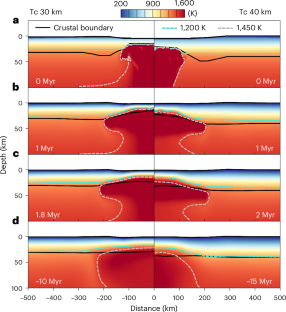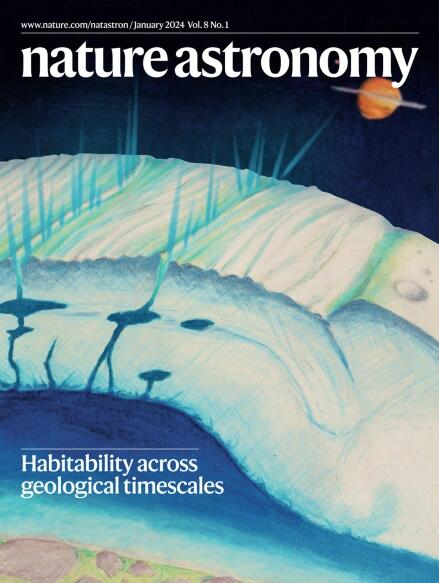月球上的古代撞击盆地被粘性松弛所湮没
IF 12.9
1区 物理与天体物理
Q1 ASTRONOMY & ASTROPHYSICS
引用次数: 0
摘要
被广泛接受的行星形成的吸积理论表明,月球在其早期历史中经历了猛烈的轰击。吸积情景预测,在其轰击历史中,总共形成了约300个大小大于300公里的盆地;然而,在月球上发现的这种大小的盆地只有40个左右。造成这种显著差异的原因尚不清楚。本文研究了月球岩浆海(LMO)凝固完成后~150 Myr内形成的撞击盆地的粘性松弛,因为只有在此之后发生的撞击才能被地壳保留。我们发现,由于下地壳的高温,LMO凝固后~100 Myr内形成的盆地可以被下地壳流入充分松弛,从而逃避重力和地形数据的检测。相比之下,后来形成的盆地应该有有限的松弛,因为下地壳较低的温度抑制了流入。我们的研究结果表明,要保留约40个盆地,月球在其历史上将发生约300-1,000次盆地形成撞击,并且LMO将在约4.3 Gyr之前凝固。lmo后盆地的温度依赖的粘性松弛为月球上观测到的盆地数量少提供了一个现实的解释。早期盆地的大量松弛表明,类地行星在岩浆海洋凝固后经历了地壳冷却,可能受到的影响比盆地记录所显示的要大得多。本文章由计算机程序翻译,如有差异,请以英文原文为准。


Obliteration of ancient impact basins on the Moon by viscous relaxation
The widely accepted accretion scenario of planet formation suggests that the Moon experienced a violent bombardment in its early history. The accretion scenario predicts that a total of ~300 basins with sizes greater than 300 km formed throughout its bombardment history; however, only ~40 basins of this size are identified on the Moon. The cause for this notable discrepancy is unknown. Here we investigate the viscous relaxation of impact basins formed within ~150 Myr after the completion of lunar magma ocean (LMO) solidification, as only impacts that happened afterwards could be retained by the crust. We find that, owing to the high temperature of the lower crust, basins formed within ~100 Myr after the LMO solidification could have been sufficiently relaxed by lower crustal inflow to escape detection in gravitational and topographic data. By contrast, basins formed afterwards should have limited relaxation, as the cooler temperature of the lower crust inhibits the inflow. Our results show that, to have ~40 retained basins, the Moon would have had ~300–1,000 basin-forming impacts throughout its history and the LMO would have solidified ~4.3 Gyr ago. The temperature-dependent viscous relaxation of post-LMO basins provides a realistic explanation for the low number of basins observed on the Moon. The substantial relaxation of early basins suggests that terrestrial planets, which experienced crustal cooling after magma ocean solidification, may have suffered far more impacts than the basin records indicate. Ancient lunar basins that formed within about 100 million years after the lunar magma ocean solidified have fully relaxed, owing to the high temperature of the lower crust, and thus escaped detection. This finding explains the discrepancy between the number of basins detected on the Moon (~40) and the number predicted (~300) by an accretion scenario of planet formation.
求助全文
通过发布文献求助,成功后即可免费获取论文全文。
去求助
来源期刊

Nature Astronomy
Physics and Astronomy-Astronomy and Astrophysics
CiteScore
19.50
自引率
2.80%
发文量
252
期刊介绍:
Nature Astronomy, the oldest science, has played a significant role in the history of Nature. Throughout the years, pioneering discoveries such as the first quasar, exoplanet, and understanding of spiral nebulae have been reported in the journal. With the introduction of Nature Astronomy, the field now receives expanded coverage, welcoming research in astronomy, astrophysics, and planetary science. The primary objective is to encourage closer collaboration among researchers in these related areas.
Similar to other journals under the Nature brand, Nature Astronomy boasts a devoted team of professional editors, ensuring fairness and rigorous peer-review processes. The journal maintains high standards in copy-editing and production, ensuring timely publication and editorial independence.
In addition to original research, Nature Astronomy publishes a wide range of content, including Comments, Reviews, News and Views, Features, and Correspondence. This diverse collection covers various disciplines within astronomy and includes contributions from a diverse range of voices.
 求助内容:
求助内容: 应助结果提醒方式:
应助结果提醒方式:


